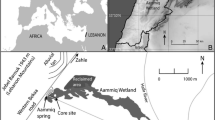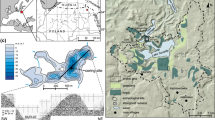Abstract
From the high alpine Sägistalsee (1935 m a.s.l.), 13.50 m of continuously laminated sediments comprising the last 9050 years, were analyzed. Even though Sägistalsee is a high elevation site, human-induced environmental changes start as early as 4300 cal. BP and leave a clearly detectable signal in the mineralogy of the sediments, which is much stronger than the signal from natural environmental changes that occurred before this time. Variations in the physical and mineralogical sediment properties of this clastic sequence reflect erosional changes in the catchment, where almost pure limestone contrasts with carbonaceous, quartz-bearing marl, and shist. The calcite/quartz (Cc/Qz) ratio was found to be most indicative of these changes, which occurred around AD 1850 and at 650, 2000, 3700, and 6400 cal. BP. The first four are interpreted as erosion events, which are related to human-induced changes in the vegetation cover and land use. We associate them to the recent development of tourism and grazing, the medieval intensification of pasturing, Roman forest clearance, and Bronze Age forest clearance, respectively. The Cc/Qz-ratio increases significantly within less than 100 years during these events, reflecting the erosion of unweathered or poorly weathered soils. The time intervals in between are characterized by a gradually decreasing Cc/Qz-ratio and reflect the stabilization or formation of new soils. Only the change at 6400 cal. BP, which represents the initial gradual stabilization of the catchment, is related to the immigration of Picea abies.
Similar content being viewed by others
References
Beniston M., Diaz H.F. and Bradley R.S. 1997. Climatic change at high elevation sites: an overview. Clim. Change 36: 233–251.
Conley D.J. 1988. Biogenic silica as an estimate of siliceous microfossil abundance in Great Lakes sediments. Biochem. 6: 161–179.
Dearing J.A. 1991. Lake sediment records of erosional processes. Hydrobiologia 214: 99–106.
DeMaster D.J. 1981. The supply and accumulation of silica in the marine environment. Geoch. Cosmoch. Acta. 45: 1715–1732.
Fanning D.S., Keramidas V.Z. and El-Desoky M. 1989. Micas. In: Dixon J.B. and Weed S.B. (eds), Minerals in Soil Environments. Soil Science Society of America, Madison, Wisconsin, pp. 551–634.
Garrels R.M. and MacKenzie F.T. 1967. Origin of the chemical composition of some springs and lakes. In: Gould R.F. (ed.), Equilibrium Concepts in Natural Water Systems. American Chemical Society, Washington D.C.. Adv. Chem. Ser. 67, pp. 222–242.
Gobet E., Hochuli, P.A. and Ariztegui D. 2001. Human Impact on the Vegetation of the Upper Engadine (Central Swiss Alps). EUG XI, J. Conf. Abs. 6: 128.
Günzler-Seiffert H. and Wyss R. 1938. Erläuterungen zur geologische Karte von Grindelwald, Blatt 396, Geologischer Atlas der Schweiz 1:25000 13, Bern.
Guthruf J., Guthruf-Seiler K. and Zeh M. 1999. Kleinseen im Kanton Bern. Gewässer und Bodenschutzlabor, Amt für Gewässerschutz und Abfallwirtschaft des Kantons Bern, 229 pp.
Heiri O. and Lotter A.F. 2003. 9000 years of chironomid assemblage dynamics in an Alpine lake: long-term trends, sensitivity to disturbance, and resilience of the fauna. J. Paleolim. 30: 273–289.
Hirt A.M., Lanci L. and Koinig K. 2003. Mineral magnetic record of Holocene environmental changes in Sägistalsee, Switzerland. J. Paleolim. 30: 321–331.
Hofmann W. 2003. The long-term succession of high-altitude cladoceran assemblages: a 9000 year record from Sägistalsee (Swiss Alps). J. Paleolim. 30: 291–296.
Koinig K., Shotyk W., Lotter A.F., Ohlendorf C. and Sturm M. 2003. 9000 years of geochemical evolution of lithogenic major and trace elements in the sediments of an alpine lake — the role of climate, vegetation, and land use history. J. Paleolim. 30: 307–320.
Leemann A. and Niessen F. 1994. Holocene glacial activity and climatic variations in the Swiss Alps: reconstructing a continuous record from proglacial lake sediments. The Holocene 4: 259–268.
Leonard E.M. and Reasoner M.A. 1999. A continuous Holocene Glacial Record Inferred from Proglacial Lake Sediments in Banff National Park, Alberta, Canada. Quat. Res. 51: 1–13.
Leonard E.M. 1986. Varve studies in Hector Lake, Alberta, Canada, and the relationship between glacial activity and sedimentation. Quat. Res. 25: 199–214.
Lotter A., Ammann B., Birks H.J.B., Heiri O., Hirt A., Lanci L., Lemcke G., Sturm M., van Leeuwen J.F.N., Walker I.R. and Wick L. 1997. AQUAREAL: A multi-proxy study of Holocene sediment archives in Alpine lakes. Würzburger Geogr. Manuskripte 41: 127–128.
Lotter A.F. and Birks H.J.B. 2003. Holocene sediments of Sägistalsee, a small lake at present-day tree-line in the Swiss Alps. J. Paleolim. 30: 253–260.
Ohlendorf C., Niessen F. and Weissert H. 1997. Glacial Varve Thickness and 127 Years of Instrumental Climate Data: A Comparison. Clim. Change 36: 391–411.
Ohlendorf C., Bigler C., Goudsmit G.H., Lemcke G., Livingstone D.M., Lotter A.F., Müller B. and Sturm M. 2000. Causes and effects of long ice cover on a remote high Alpine lake. J. Limnol. 59: 65–80.
Seeber H. 1911. Geologische Kartenskizze desGebietes östlich vom Lauterbrunnental 1:50000. Geogr. artist. Anstalt Kümmerly &; Frey, Bern.
St. Arnaud R.J. and Sudom M.D. 1981. Mineral Distribution and Weathering in Chernozemic and Luvisolic Soil from Central Saskatchewan. Can. J. Soil Sci. 61: 79–89.
Sturm M. and Matter A. 1978. Turbidites and varves in Lake Brienz (Switzerland): deposition of clastic detritus by density currents. Spec. Pub. Int. Ass. Sed. 2: 147–168.
Sturm M. 1979. Origin and composition of clastic varves. In: Schlüchter Ch. (ed.), Moraines and Varves. A.A. Balkema, Rotterdam, pp. 281–285.
Tinner W. and Ammann B. 1996. Treeline fluctuations recorded for 12,500 years by soil profiles, and plant macrofossils in the central Swiss Alps. Arct. Alp. Res. 28: 131–147.
Wick L., van der Knaap W.O., Leeuwen J.F.N. and Lotter A.F. 2003. Holocene vegetation development in the catchment of Sägistalsee (1935 m a.s.l.), a small lake in the Swiss Alps. J. Paleolim. 30: 261–272.
Wick L. and Tinner W. 1997. Vegetation changes and timberline fluctuations in the Central Alps as indicators of Holocene climatic Oscillations. Arct. Alp. Res. 29: 445–458.
Wyss R. 1990. Die frühe Besiedlung der Alpen aus archäologischer Sicht. Mit 17 Abbildungen. Siedlungsforschung Archäologie-Geschichte-Geographie 8: 69–86.
Zar J. 1984. Biostatistical Analysis. Prentice-Hall, New Jersey, 718 pp.
Author information
Authors and Affiliations
Rights and permissions
About this article
Cite this article
Ohlendorf, C., Sturm, M. & Hausmann, S. Natural environmental changes and human impact reflected in sediments of a high alpine lake in Switzerland. Journal of Paleolimnology 30, 297–306 (2003). https://doi.org/10.1023/A:1026032829150
Issue Date:
DOI: https://doi.org/10.1023/A:1026032829150




